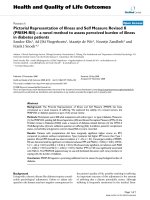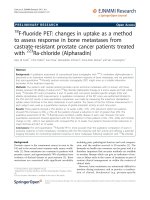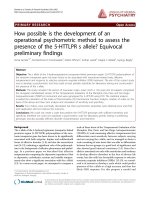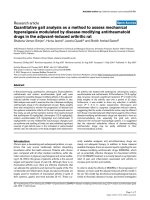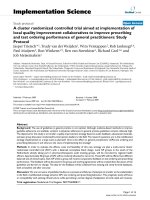Development of quality index method to assess freshness and shelf life of black tiger shrimp (Penaeus monodon) stored at 0 °c
Bạn đang xem bản rút gọn của tài liệu. Xem và tải ngay bản đầy đủ của tài liệu tại đây (1.02 MB, 10 trang )
Natural Science
ISSN 1859–1388
/>Vol. 126, No. 1B, 2017, P. 19–28
DEVELOPMENT OF QUALITY INDEX METHOD TO ASSESS
FRESHNESS AND SHELF-LIFE OF BLACK TIGER SHRIMP
(PENAEUS MONODON) STORED AT 0 °C
Le Nhat Tam1, 2*, Nguyen Nam Giao1, Tran Thi Ngoc Nhung1, Dao Bich Duyen1,
Le Thi Hong Nhung1, Nguyen Ba Thanh1, Tran Thi Van Thi2
1
Industrial University of Ho Chi Minh City, 12 Nguyen Van Bao St., P.4, Q. Go Vap,
Ho Chi Minh City, Vietnam
2 HU – University of Sciences, 77 Nguyen Hue St., Hue, Vietnam
Abstract: Black tiger shrimps (Penaeus monodon) were harvested and stored at 0 °C for study. A quality
index method (QIM) developed to evaluate the freshness of black tiger shrimp is presented in this study.
The terms used to describe all the changes related to the texture, color, and odor are carefully chosen. The
development of the QIM scheme includes three main steps: a preliminary scheme to evaluate all the
changes of attributes related to quality; a final QIM scheme and training; and a validation of the QIM
scheme and an estimation comparing the remaining shelf-life and the actual shelf-life. The results show
that the shelf-life of the black tiger shrimp in the ice storage is 8 days. The quality score involving attributes decreases during the storage time and has a correlation close to the linear regression equation. The
scheme of the validation quality of the black tiger shrimp using the QIM method allows the estimation of
the remaining shelf life.
Keywords: black tiger shrimp, quality index method
1
Introduction
Nowadays, consumers are interested in high-quality safe and healthy foods [1]. Moreover, in order to secure the food safety, it is necessary to maintain the high quality of seafood in
each link of the whole complex chain from catch to consumer [2]. For commercialization, it is
essential to estimate accurately its freshness, one of the most important aspects of fish and fish
products [3, 4]. Thus, the need for rapid analytical techniques to measure the food quality and
freshness is greater than ever. A lot of methods have been evaluated, but sensory method is still
used as the most effective technique to assess seafood freshness and quality degradation [5].
Sensory evaluation is the most important method in freshness assessments. Sensory evaluation
is defined as the scientific discipline used to evoke, measure, analyze, and interpret reactions to
characteristics of food as perceived through the senses of sight, smell, taste, touch, and hearing
[6]. There are two types of sensory methods, subjective and objective. Fish freshness is most
commonly determined by objective scoring based on organoleptic changes that occur as fish
storage time is extended [7]. QIM method is sensory objective method. The QIM, originally developed by the Tasmanian Food Research Unit in Australia [8] and improved further, is consid* Corresponding:
Submitted: 13–7–2016; Revised: 12–10–2016; Accepted: 02–3–2017
Le Nhat Tam et al.
Vol. 126, No. 1B, 2017
ered to be rapid and reliable to measure the freshness of whole fish stored in ice [9]. This method is based on significant sensory parameters (skin, eyes, color, texture, odor and the black
spots appear on the cuticle and the telson of shrimps) for raw fish [8, 10], and the characteristics
listed on the sheet are assessed and appropriate demerit point score is recorded (from 0 to 3).
The scores for all characteristics are summed to give the overall sensory score. Quality index
(QI) is close to 0 for very fresh fish, whereas higher scores are obtained as the fish deteriorates
[16, 26]. During the development of QIM, one of the objectives is to develop a linear correlation
between the sensory quality (expressed as the QI) and the storage time in ice, which makes it
possible to predict the remaining shelf-life in ice [11–13]. The maximum storage time in ice is
defined as the day when the fish is unfit for human consumption. Therefore, the remaining
shelf-life (in days in ice) can be calculated on the basis of the correlation between the QI and
storage time in ice and information about the quality index corresponding to the time of rejection. Recently developed QIM schemes were presented for raw gilthead sea bream (Sparus aurata) [14], farmed Atlantic salmon (Salmo salar) [12], fresh cod (Gadus morhua) [15], common octopus (Octopus vulgaris) [16], herring (Clupea harengus) [17]. The advantages of QIM are that it
requires short training, is rapid and easy to perform, and is nondestructive and can be used as a
tool in production planning and quality warranty work [11].
The aim of this work was to provide all the organoleptic changes of black tiger shrimp in
ice storage and develop the QIM scheme evaluation quality for this product.
2
Materials and methods
2.1
Shrimp collection and storage
Black tiger shrimp were harvested fresh from three different farms located in Ca Mau
Province – Vietnam. The shrimps with signs of visual defect or breakage were removed. After
harvest, the live shrimps were washed in clean filtered flowing water and placed in sterile
Reynolds zipper (26.8 cm × 27.9 cm) polyethylene bags (Alcoa Products Inc., Richmond, VA
23261, USA), distributed uniformly in the styrene foam boxes between layers of ice with a
shrimps/ice ratio of 1:2 (w/w) and transported to the laboratory after 8 hours. At the laboratory,
polyethylene bags containing shrimp samples were kept in a cold room (0 °C) for study. Shrimp
sample of day 0 was determined soon after being transferred to the lab.
2.2
Developing QIM scheme method
Developing the terms for description of the changes in attributes of black tiger shrimp stored
in ice
The terms describe the changes in attributes related to texture, odor, color of black tiger
shrimp collected from observation, and from data of previous researches [18–22]. Descriptive
words should be carefully selected, and the panelists trained should agree with the terms. Objective terms should be used rather than subjective terms. It is necessary that the terms used to
describe the sensory are short, clear, and understandable for the experts.
20
Joshueuni.edu.vn
Vol. 126, No. 1B, 2017
Formation and improvement of QIM scheme
Developing a QIM scheme includes three mainly steps.
+ Step 1 – Preliminary scheme: Three experts in sensory evaluation of shrimps observe all
changes in quality attributes characteristic (appearance, odor, carapace texture, carapace color,
eye, shell color, the black spots appear on the cuticle and the telson of shrimps, etc.) and put
them into the preliminary scheme. Each attribute is scored from 0 to 3 with low scores indicating the best quality.
+ Step 2 – Final scheme and training: Shrimp samples were stored at 0 °C and evaluated
daily for ten days. There are 6 experts joining in training sessions. The black tiger shrimps
stored at different periods of time in ice as previously reported were examined. In this stage,
storage time information was provided to panellists for associating the change with the correct
time. Next, the evaluation should be performed without knowing the storage period until the
evaluation results have been achieved with reliability, accuracy, and precision. The necessary
changes in scheme are made.
+ Step 3 – Validation of QIM scheme: Shrimp samples preserved in ice were evaluated according to the QIM scheme, which was developed in step 2. The correlation equation between
the storage time and the quality score was developed in this step. Correlation equation was
used to determine the remaining shelf-life of shrimps, and to compare with the actual shelf life.
The experiments for evaluation of the scheme were performed on 10 different samples.
2.3
Statistical analysis
All measurements were carried out in triplicate. Data were subjected to analysis of variance (ANOVA) using the general linear models procedure of the statistical analysis system
software of Statgraphics centurion. Differences among the mean values of the various treatments and storage time were determined using the least significant difference (LSD) test, and
the significance was defined at p < 0.05.
3
Results and discussion
3.1
The changes of attributes of black tiger shrimp with storage time
The goals are to evaluate the organoleptic changes of shrimps in ice storage, including
color, texture, and odor, and other various attributes, as follows:
Color:
+ The order of color changes at the head is: slightly red – bluish – slightly dark – dark
+ The order of color changes at the body is: Bluish white, brightness – Bluish white, and
slightly loss of brightness – Slightly red, opaque, and spotted – Reddish, spotted
+ The order of color changes at the tail is: Slightly red – Bluish – Slightly dark – Dark
21
Le Nhat Tam et al.
Vol. 126, No. 1B, 2017
+ The order of color changes at the meat is: Pearly white – Lime colored – Slightly pinkish
– Pinkish or light yellow
Texture:
+ The order of texture changes at the appearance is: Shape intact, head firmly attached to
body shape intact, head slightly attached to body where tissues around neck flesh loosely
attached to shell, head loosely attached to body remain loose flesh loosely attached to shell,
head very loosely attached to body
+ The order of texture changes at the meat is: Hard slightly soft soft very soft
Odor:
+ The order of odor changes at the shrimps is: Fresh seaweed slight or no odor
sour
The problem of discoloration is one of the most serious concerns of the seafood industry.
The discoloration is usually due to black spot development, also called melanosis. Melanosis is
the harmless but unappealing surface discoloration on shrimps, crabs or lobsters and is caused
by the enzymatic oxidation of colorless phenols into quinones (Fig. 2), which undergo nonenzymatic polymerization generating dark insoluble pigments [23].
Fig. 1. Melanin formation due to PPO activation scheme on crustaceans [24]
Yellow discoloration is due to the migration of carotenoid pigments from chromatophore
or carotenoprotein complexes in the skin to the subcutaneous fat layers. The oxidation of carotenoid pigments also results in fading of the pink or red color of fish flesh or skin when stored in
ice or at chilling temperature [25]. Suyama and Konosu [26] reported that softening due to the
collagen layer is destroyed. Moreover, fish and shellfish muscles also contain less connective
tissue than those of mammals and thus, the cross-links formed by their collagens are not as extensive. All these factors contribute to an enhanced rate of fish and shellfish flesh softening. The
22
Joshueuni.edu.vn
Vol. 126, No. 1B, 2017
tenderization or flesh softening is considered to be associated with the disappearance of Zdisks, dissociation of actomyosin complex, destruction of connection, and general denaturation
of collagenous tissue [27, 28].
3.2
QIM scheme for sensory evaluation of black tiger shrimp
For this current study, the sensory characteristics (color, texture and odor) and (parts of) sample, with subsequent description and scores, are shown in Table 1.
Table 1. QIM scheme for sensory evaluation of black tiger shrimp (Penaeus monodon)
Characteristics
Head
Body
Color
Tail
Meat
Appearance
Texture
Meat
Description
Score
Bright pink, no spots
0
Bright blue–green, no spots
1
Blue–green or slight dark, moderately spots
2
Dark
3
Blue–green, brightness and iridescent
0
Grey–greenish, loss of brightness and slightly opaque
1
Brownish red, opaque, moderately spots
2
Dark
3
Bright pink, no spots
0
Bright blue–green, no spots
1
Blue–green or slight dark, moderately spots
2
Dark
3
Pearly white
0
lime color
1
Slightly pinkish
2
Pinkish or light yellow
3
Shape intact, head firmly attached to body
0
Shape intact, head slightly attached to body where tissues
around neck
1
Flesh loosely attached to shell, head loosely attached to body
remain loose
2
Flesh loosely attached to shell, head very loosely attached to
body
3
Hard, elastic texture
0
Slightly soft, loss of elastic
1
Moderately soft
2
23
Le Nhat Tam et al.
Odor
3.3
Odor
Vol. 126, No. 1B, 2017
Soft and watery texture
3
Fresh
0
Sea weed
1
Slightly or no odor
2
Sour
3
Organoleptic changes of black tiger shrimp stored in ice
The changes in organoleptic attributes with storage time has been quantified, as depicted in
Table 2.
Table 2. Organoleptic changes, QI and grade of black tiger shrimp undergoing storage in ice
Storage
days
Description
QI
0
Bright pink head and tail, blue–green body, bright and iridescent shell.
Fresh pearly white, hard and elastic meat, shape intact, head firmly
attached to body, fresh odor.
0.93
1
Bright pink head and tail, blue–green body, bright and iridescent shell.
Fresh pearly white, hard and elastic meat, shape intact, head firmly
attached to body, fresh odor.
1.53
2
Bluish head and tail, blue–green body, slight loss of body brightness,
iridescent, fresh pearly white, hard and elastic meat, shape intact, head
firmly attached to body, fresh odor.
3.67
3
Bright blue–green head and tail, grey-greenish body, slight loss of
brightness and slightly iridescent, fresh meat with characteristics lime
color, hard and elastic; shape intact, head firmly attached to body, fresh
odor.
5.60
4
Bright blue–green head and tail, slightly spot, grey-greenish body,
slightly spots, loss brightness and slightly opaque; fresh meat with characteristics lime color, loss elastic and slightly soft; shape intact, head
slightly attached to body where tissues around neck; odor of seaweed.
7.47
5
Blue–green head and tail, moderately spot, grey-greenish body, slightly
spots, loss of brightness and slightly opaque; fresh meat with characteristics of lime color, loss of elastic and slightly soft; shape intact, head
slightly attached to body where tissues around neck; odor of seaweed.
9.53
6
Blue–green head and tail, grey-greenish or brownish red body, moderate spots, no brightness, moderately opaque, slightly pink meat, moderately soft; flesh loosely attached to shell, head loosely attached to body,
neutral odor.
11.37
7
Blue–green or slightly dark head and tail, grey-greenish or brownish red
body, moderate spots, no brightness, moderately opaque, slightly pinkish meat, moderately soft, flesh loosely attached to shell, head loosely
attached to body, neutral odor.
12.93
24
Grade
Excellent
Very good
Good
Acceptable
Joshueuni.edu.vn
Vol. 126, No. 1B, 2017
8
Slightly dark head and tail, brownish red body, moderate spots, no
brightness, opaque, pinkish meat, soft; flesh loosely attached to shell,
head loosely attached to body, slightly sour odor
14.43
9
Dark head and tail, slight body spots, yellow meat, soft; flesh loosely
attached to shell, head loosely attached to body, sour odor.
15.93
10
Dark head and tail, dark body, spots. Yellow meat, soft and watery texture; flesh loosely attached to shell, head loosely attached to body, sour
odor.
Moderately
acceptable
Rejected
16.93
The changes of organoleptic qualities of black tiger shrimp can be classified into six phases corresponding to the periods of 0 to 1, 2 to 3, 4 to 5, 6 to 7, 8, and 9 to 10 days storage in ice;
the phases are denoted as I to VI, respectively. In phase I, the shrimps just passed the rigor mortis and did not change in texture and color. The quality of shrimps was excellent with QI from
0.93 to 1.53. In phase II, organoleptic characteristics of shrimps were similar to those of phase I,
nevertheless there was a slight change in color of head and tail with QI from 3.67 to 5.60. In
phase III, there was a slight loss of brightness, and the body became slightly opaque. Fresh
slightly soft, less elastic meat with the characteristics of lime color, and there were a few spots
on head and tail. The quality of shrimps was good with QI from 7.47 to 9.53. In phase IV, there
was a lot of color change in head and tail; they were slightly dark; the head loosely attached to
the body. The body was slightly reddish and moderately opaque with moderate spots. The
slightly pinkish, soft flesh loosely attached to the shell. The quality of shrimps was acceptable
with QI from 11.37 to 12.93. In phase V, the organoleptic characteristics were the same as those
in phase IV, but the meat was pinkish and began to have slightly sour odor. The quality of
shrimps was moderately acceptable with QI of 14.43. In phase VI, the organoleptic characteristics of shrimps became unacceptable. The quality of shrimps was categorized as rejected with
QI from 15.93 to 16.93. Thus, our results showed that the shelf-life of shrimps stored in ice was 8
days. Some researchers evaluated the fresh seafood quality using a sensory method, showing
that the shelf-life of ice storage black tiger shrimp was from day 8 to day 10 [18, 22, 29], and the
shelf-life of ice storage Pacific white shrimps was 8 days [30]. The organoleptic changes of black
tiger shrimp with the storage time are shown in Fig. 2. In general, the QI increases with the
storage time, and the increase is significant with p < 0.05. The regression equation has the form:
y = 1.7139x + 0.5546 (R2 = 0.9938). Martinsdóttir [5] also reported that the Quality Index increased linearly with the storage time of fish in ice.
25
Le Nhat Tam et al.
Vol. 126, No. 1B, 2017
y = 1.7139x + 0.5546
R² = 0.9938
QI
20
18
16
14
12
10
8
6
4
2
Days
0
0
2
4
6
8
10
12
Fig. 2. Changes of QI of black tiger shrimp in ice during 10 days
3.4
Validation of QIM scheme for black tiger shrimp
The Table 3 shows the results the actual and postulated shelf-life values actually based on the
calculated equation.
Table 3. Validation of QIM scheme by estimated shelf-life and actually remaining shelf-life
Sample
QI
Equivalent number of Estimated shelf-life according to
days storage in ice
QIM scheme
Actually remaining shelf-life
Sample 1
3.22
1.5
6.5
6.2, 6.3, 6.6
Sample 2
1.77
0.7
7.3
7.2, 7.4, 7.3
Sample 3
5.89
3.1
4.9
4.8, 5.1, 5.2
Sample 4
9.76
5.4
2.6
2.4, 2.7, 2.8
Sample 5
6.32
3.4
4.6
4.5, 4.7, 4.7
Sample 6
12.67
7.1
0.9
0.8, 0.8, 1.0
Sample 7
4.72
2.4
5.6
5.5, 5.7, 5.8
Sample 8
8.59
4.7
3.3
3,4, 3.5, 3.4
Sample 9
11.35
6.3
1.7
1.8, 1.9, 2.2
Sample 10
10.45
5.7
2.3
2.0, 2.2, 2.4
The resulting validation shows that the estimated remaining shelf-life of the experimental
samples had a significant difference (p < 0.05) compared with the actually remaining shelf life.
The values of actually remaining shelf-life were close to the remaining shelf-life calculated from
26
Joshueuni.edu.vn
Vol. 126, No. 1B, 2017
the regression equation, and this results demonstrated that our QIM scheme can be used to
evaluate the freshness and to classify the shrimp quality.
4
Conclusion
The assessment of quality and shelf-life of black tiger shrimp (Penaeus monodon) freshly
harvested and stored at 0 °C was presented in this paper. The shelf-life of the shrimps was determined to be 8 days under the storage condition using the quality index method developed in
this paper. In the response to the increase in the demand for information about the quality and
freshness by the consumers and growth of economy commerce, the quality index method appears to be an easy, rapid and efficient tool to assess the storage history and estimate the remaining shelf-life of black tiger shrimp specifically and seafood generally. The new quality index method can be used to combine chemical quality indices for freshness to create a complete
program evaluation of black tiger shrimp.
Reference
1. Sen D. (2005), Advances in fish processing technology, Vol. 1. Allied Publishers.
2. Hyldig G., Green-Petersen D.M. (2004), Quality Index Method—an objective tool for determination of
sensory quality, Journal of aquatic food product technology, 13(4) 71–80.
3. Olafsdottir G. (1997), Methods to evaluate fish freshness in research and industry, Trends in Food
Science & Technology, 8(8) 258–265.
4. Huidobro A. (2001), Washing effect on the quality index method (QIM) developed for raw gilthead
seabream (Sparus aurata), European Food Research and Technology, 212(4) 408–412.
5. Martinsdóttir E., Bremner H. (2002), Quality management of stored fish, Safety and quality issues in fish
processing, 360–378.
6. Huss H. H. (1995), Quality and quality changes in fresh fish, FAO fisheries technical paper, 348.
7. Connell J., Shewan J. (1980), Sensory and non-sensory assessment of fish. in Advances in fish science and
technology: papers presented at the Jubilee conference of the Torry Research Station, Aberdeen, Scotland, 23–27
July 1979, edited by JJ Connell and staff of Torry Research Station, Farnham, Surrey, England, Fishing
News Books.
8. Bremner H. (1985), A convenient, easy to use system for estimating the quality of chilled seafoods. Fish
Processing Bulletin,.
9. Botta J. R. (1995), Evaluation of seafood freshness quality, John Wiley & Sons.
10. Branch A., Vail A. (1985), Bringing fish inspection into the computer age, Food Technology in Australia,
37(8) 352–355.
11. Hyldig G.,Nielsen J. (1998), A rapid sensory method for quality management, in Methods to determine the
freshness of fish in research and industry., IIR.
12. Sveinsdottir K. (2003.), Quality Index Method (QIM) scheme developed for farmed Atlantic salmon
(Salmo salar), Food Quality and Preference, 14(3) 237–245.
13. Luten J., Martinsdottir E. (1997), QIM: a European tool for fish freshness evaluation in the fishery
chain..
27
Le Nhat Tam et al.
Vol. 126, No. 1B, 2017
14. Huidobro A., Pastor A., Tejada M. (2000), Quality index method developed for raw gilthead seabream
(Sparus aurata), Journal of Food Science, 65(7) 1202–1205.
15. Bonilla A. C., Sveinsdottir K., Martinsdottir E. (2007), Development of Quality Index Method (QIM)
scheme for fresh cod (Gadus morhua) fillets and application in shelf life study, Food control, 18(4) 352–
358.
16. Barbosa A. Vaz-Pires P. (2004), Quality index method (QIM): development of a sensorial scheme for
common octopus (Octopus vulgaris), Food Control 15(3) 161–168.
17. Nielsen D., Hyldig G. (2004), Influence of handling procedures and biological factors on the QIM
evaluation of whole herring (Clupea harengus L.), Food research international, 37(10) 975–983.
18. Hanpongkittikun A., Siripongvutikorn S., Cohen D. L. (1995), Black tiger shrimp (Penaeus monodon)
quality changes during iced storage, Asean Food Journal (Malaysia),.
19. Azam K., Alam S. N., Naher S. S. (2010), Quality assessment of farmed black tiger shrimp (Penaeus
monodon) in supply chain: Organoleptic evaluation, Journal of Food Processing and Preservation, 34(s1)
164–175.
20. Archer M. (2010), Sensory assessment score sheets for fish and shellfish-Torry & QIM, Edinburgh:
Seafish.
21. TCVN 3726–89,Tôm nguyên liệu tươi, Fresh shrimps for food processing, 3726–3789.
22. Liên D. T. P. (2011), Đánh giá nhanh độ tươi tôm sú nguyên liệu (Penaeus monodon) bảo quản trong
nước đá (0–4oc) theo phương pháp chỉ s ố chất lượng QIM, Tạp chí Khoa học ,: p. 10.
23. Nirmal N. P.,Benjakul S. (2011), Inhibition of melanosis formation in Pacific white shrimp by the
extract of lead (Leucaena leucocephala) seed, Food chemistry, 128(2) 427–432.
24. Gonçalves A. A., Oliveira A. R. M. (2016), Melanosis in crustaceans: A review, LWT–Food Science and
Technology, 65, 791–799.
25. Haard N. (1992), Biochemistry and chemistry of color and color change in seafoods, , Technomic Publishing
Co. Inc., Lancaster and Basel.
26. Suyama M., Konosu A. (1987), Postmortem changes of fish and shellfish, Marine Food Science (Suison
Shokuhin-Gaku),.
27. Koohmaraie M. (1988), Role of Ca++‐Dependent Proteases and Lysosomal Enyzmes in Postmortem
Changes in Bovine Skeletal Muscle, Journal of Food Science, 53(5) 1253–1257.
28. Koohmaraie M., Schollmeyer J., Dutson T. (1986), Effect of Low‐Calcium‐Requiring Calcium Activated
Factor on Myofibrils under Varying pH and Temperature Conditions, Journal of Food Science,. 51(1) 28–
32.
29. Jayaweera V., Subasinghe S. (1990), Some chemical and microbiological changes during chilled storage of
prawns (Penaeus indicus), FAO Fisheries Report (FAO).
30. Okpala, C.O.R., W.S. Choo, and G.A. Dykes (2014), Quality and shelf life assessment of Pacific white
shrimp (Litopenaeus vannamei) freshly harvested and stored on ice, LWT–Food Science and Technology,.
55(1), 110–116.
28


